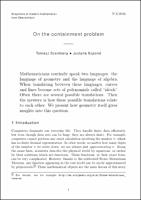| dc.contributor.author | Szemberg, Tomasz | |
| dc.contributor.author | Szpond, Justyna | |
| dc.contributor.editor | Niediek, Johannes | |
| dc.contributor.editor | Cederbaum, Carla | |
| dc.date.accessioned | 2016-03-23T11:45:13Z | |
| dc.date.available | 2016-03-23T11:45:13Z | |
| dc.date.issued | 2016 | |
| dc.identifier.uri | http://publications.mfo.de/handle/mfo/458 | |
| dc.description.abstract | Mathematicians routinely speak two languages: the language of geometry and the language of algebra. When translating between these languages, curves and lines become sets of polynomials called “ideals”. Often there are several possible translations. Then the mystery is how these possible translations relate to each other. We present how geometry itself gives insights into this question. | en_US |
| dc.language.iso | en_US | en_US |
| dc.publisher | Mathematisches Forschungsinstitut Oberwolfach | en_US |
| dc.relation.ispartofseries | Snapshots of modern mathematics from Oberwolfach; 2016,03 | |
| dc.rights | Attribution-ShareAlike 4.0 International | * |
| dc.rights.uri | http://creativecommons.org/licenses/by-sa/4.0/ | * |
| dc.title | On the containment problem | en_US |
| dc.type | Article | en_US |
| dc.identifier.doi | 10.14760/SNAP-2016-003-EN | |
| local.series.id | SNAP-2016-003-EN | |
| local.subject.snapshot | Algebra and Number Theory | |
| dc.identifier.urn | urn:nbn:de:101:1-201603113112 | |
| dc.identifier.ppn | 1655532049 | |


